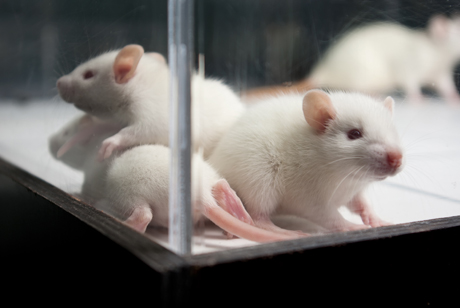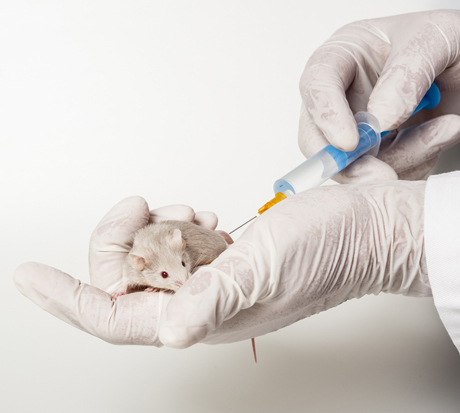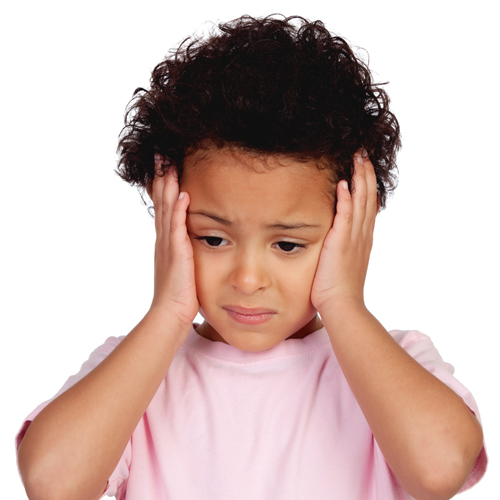Transgenerational Transmission of Drug Exposure and Stress in Rodents
New data suggest that there can be transgenerational transmission of the effects of drug exposure and stress from a paternal rat to its offspring. The father mates with a female who was not exposed to drugs or stress and never has any contact with the offspring. Consensus is now building that this transmission occurs via epigenetic alterations in sperm.
Epigenetic alterations are those that are mediated by chemical changes in the structure of DNA and of the histones around which DNA is wrapped. These changes do not alter the inherited gene sequences but only alter how easy it is for genes encoded in the DNA to be activated (transcribed) or suppressed (inhibited).
There are three common types of epigenetic modifications. One involves the attachment of a methyl or acetyl group to the N-terminals of histones. Methylation typically inhibits transcription while acetylation activates transcription. Histones can also be altered by the addition of other compounds. The second major type of epigenetic change is when the DNA itself is methylated. This usually results in inhibition of the transcription of genes in that area. The third epigenetic mechanism is when microRNA (miRNA) binds to active RNA and changes the degree to which proteins are synthesized.
At a recent scientific meeting, researchers described the various ways epigenetic changes can be passed on to future generations.
Researcher Chris Pierce reported that chronic cocaine administration increased brain-derived neurotrophic factor (BDNF) in the medial prefrontal cortex of rats. (BDNF is important for learning and memory.) The cocaine administration led to acetylation of the promoter for BDNF.
This exposure to cocaine in male rats who then fathered offspring led to two changes in the offspring, presumably conveyed by epigenetic changes to the fathers’ sperm. The first change was a decrease in cocaine reinforcement. The offspring took longer to acquire a cocaine self-administration habit. The second change was long-lasting learning deficits in the male offspring, specifically recognition of novel objects. The deficit was associated with a reduction in long-term potentiation in the offspring. Long-term potentiation is the strengthening of synapses that occurs through repeated patterns of activity. Surprisingly, the following generation also showed deficits in learning and memory, but did not show a loss of long-term potentiation.
Editor’s Note: These data indicate that alterations in sensitivity to cocaine (in this case slower acquisition of cocaine self-administration) can be transferred to a later generation, as can learning deficits in males. These data suggest that fathers’ experience of drugs can influence cocaine responsiveness and learning via epigenetic mechanisms likely mediated via epigenetic changes to the father’s sperm.
This research suggests the possibility that, in a human clinical situation, there would be three ways that a father’s drug abuse could affect his child’s DNA. First, there is the traditional genetic inheritance, where, for example, an increased risk for drug abuse is passed on to the child via the father’s genetic code. Next, drug abuse brings about epigenetic changes to the father’s sperm. (His genetic code remains the same, but acetyl groups attach to the BDNF promoter section of his DNA, changing how those proteins get produced.) Lastly, if the father’s drug abuse added stress to the family environment, this stress could have epigenetic effects on the child’s DNA.
Researcher Alison Rodgers described how epigenetic changes involving miRNA in paternal rats influence endocrine responsivity to stress in their offspring. Rodgers put rats under stress and observed a decrease in hormonal corticosterone response to stress. When a father rat was stressed, nine different miRNAs were altered in its sperm. To prove that this stress response could be passed on transgenerationally via miRNAs, the researchers took sperm from an unstressed father, loaded it with one or all nine miRNAs from the stressed animal, and artificially inseminated female rats. Rodgers found that the sperm containing all nine miRNAs, but not the sperm carrying one randomly selected miRNA, resulted in offspring with a blunted corticosterone response to stress.
Researcher Eric Nestler showed that when a rodent goes through 10 days of defeat stress (being defeated repeatedly by a larger animal), they begin to exhibit behaviors resembling those seen in depression. Social avoidance was the most robust change, and continued for the rest of the animal’s life. Animals did not have to be physically attacked by the bigger animal to show the depression-like effects of defeat stress. Just witnessing the repeated defeats of another rat was sufficient to produce the syndrome. Again, father rats that experienced defeat stress or witnessed it passed this susceptibility to defeat stress on to their offspring (with whom they never had any contact), likely by epigenetic changes to sperm. Read more
Lithium Extends Anti-Depressant Effects of Ketamine in Mice
While it can sometimes take weeks for the effects of antidepressant treatments to appear, intravenous ketamine can produce antidepressant effects in as little as two hours. However, ketamine’s effects fade after three to five days. New animal research by Chi-Tso Chiu et al. explores whether adding lithium to ketamine treatment can produce more sustained antidepressant effects.
Mice who are restrained by being placed in a tube for several hours (chronic restraint stress) exhibit a behavioral and neurochemical profile that resembles human depression. When Chiu and colleagues pretreated these stressed mice with sub-therapeutic doses of lithium (600 mg/L) in their drinking water for several weeks, a sub-therapeutic dose of ketamine (2.5 mg/kg of body weight) was enough to produce robust antidepressant effects in the mice, while neither drug alone was effective at these doses.
The combination of ketamine and lithium also restored the density of spines on the dendrites of neurons in the medial prefrontal cortex. Post-treatment with lithium (1200 mg/L) for several weeks was also successful in extending the effects of a single (50 mg/kg) ketamine injection.
Both lithium and ketamine affect the intracellular signaling pathway mTOR. Ketamine activates the pathway, increasing levels of synaptic proteins and dendritic spine density. It also increases brain-derived neurotrophic factor (BDNF) and the BDNF receptor TrkB. BDNF is important for learning and memory.
When lithium was added to the treatment of the mice with ketamine, the mTOR and BNDF pathways were further activated. Lithium also inhibits the receptor GSK-3, supporting ketamine’s rapid-acting antidepressant effects.
Ketamine treatment can produce oxidative stress, in which toxic free radicals can endanger cells, and the addition of low doses of lithium also completely prevented this neurochemical side effect.
Chiu and colleagues hope that the findings of this study in mice can eventually be applied to research in humans in the hopes of finding a clinical option that would sustain the rapid-onset antidepressant effects of ketamine for the long term.
Combination of Lamotrigine and Quetiapine Superior to Quetiapine Alone
At a recent scientific meeting, researcher John Geddes and colleagues reported that compared to adding placebo to the treatment of bipolar depressed patients already receiving the atypical antipsychotic quetiapine, adding the mood stabilizing drug lamotrigine led to significant improvements in their illness. Lamotrigine was slowly titrated to doses of 200mg/day. (Slowly increasing dosage is important because a serious rash is a possible side effect of lamotrigine, occuring in about one in 5,000 individuals exposed.)
Researcher Charles Bowden found in 2000 that adding lamotrigine to valproate improved its effectiveness, as Marc van der Loos found in 2008 with lamotrigine and lithium. Thus it appears that adding lamotrigine to a mood stabilizer or to an atypical antipsychotic like quetiapine is a good second-line option in the treatment of bipolar depression. While lamotrigine is not FDA-approved for the acute treatment of depression, this approach is worthy of consideration, and could be of immediate clinical use. It provides an alternative to adding a unimodal antidepressant, which recent meta-analyses have indicated is not effective and which can increase switches into mania, cycle acceleration, or even treatment resistance in patients with bipolar disorder.
Keith O’Neil: A Football and Public Health Hero
 Keith O’Neil is a former Super Bowl champion and the founder of the Forever Foundation, an organization whose mission is to educate the public about bipolar disorder and to de-stigmatize the illness. In September he spoke at the Brain and Behavior Research Foundation (formerly NARSAD) meeting in Washington, DC.
Keith O’Neil is a former Super Bowl champion and the founder of the Forever Foundation, an organization whose mission is to educate the public about bipolar disorder and to de-stigmatize the illness. In September he spoke at the Brain and Behavior Research Foundation (formerly NARSAD) meeting in Washington, DC.
O’Neil’s life story holds many important lessons— not only about the difficulties of bipolar illness, but also about the hope of recovery. He described being six years old and experiencing high levels of anxiety and fear, and an inability to get to sleep. His mind raced and he was so irritable that he was nicknamed “The Bear.”
The anxiety and the racing thoughts continued, and O’Neil became increasingly depressed. When he was 10 or 12 years old, he began to experience suicidal thoughts and searched his parents’ medicine cabinet for pills he could use to commit suicide. Anxiety and depression became more prominent even though he was an “A” student, one of the most popular kids at school, and an extraordinary athlete, and had a loving family and many friends. He began to use alcohol excessively, had conduct problems, was impulsive and was always in trouble.
O’Neil excelled in football in high school, started college at Northern Arizona University, and quickly became an All-American linebacker at Penn State. He was a first-round draft pick for the New York Giants. His teammates would nap between workouts for coach Bill Parcells, but instead, O’Neil would sit and cry over his inability to sleep. When he was later picked up by the Dallas Cowboys as a free agent, he was unable to sleep for five nights.
O’Neil moved on to the Indianapolis Colts. He did not sleep for four nights before his first game, and told coach Tony Dungy that he needed help, as he did not think he could play the next day. Dungy took him seriously and had him meet with the general manager, the team doctor, and the trainer. O’Neil felt extraordinarily relieved to be able to talk about his anxiety for the first time and took some clonazepam (Klonopin) for sleep and anxiety. Although he missed his first game, he became increasingly successful and the captain of the team that three years later would go on to win the Super Bowl.
O’Neil returned to the Giants for five seasons. While in New York, his wife miscarried, triggering O’Neil’s first major manic episode. He felt super human, spent excessive amounts of money (bought a Rolex watch and three diamond earrings), did not need sleep, and was generally out of control. In 2010, O’Neil was diagnosed with bipolar disorder by Steven Dubovsky, one of the pioneers in the development of calcium channel blockers for the treatment of bipolar disorder.
After his manic episode, O’Neil swung into a severe 18 month–long depression, which he described as “the depths of hell.” He gradually improved and started on a regimen that included medications, exercise, and relying on his family for comfort and support. He then moved to Phoenix, Arizona to start his foundation—the Forever Foundation.
The foundation provides information about the illness and promotes de-stigmatization. O’Neil visits high schools to teach students about bipolar illness and the importance of talking about anxiety and depression and getting help.
In the question and answer period following his talk, O’Neil discussed his own treatment. His early experiences with antidepressants were somewhat positive for his depression and anxiety, but may have been influential in his first manic episode. He said he is now well, and described his current medication regimen, which includes lithium, the mood stabilizing anticonvulsant oxcarbazepine (called Trileptal, which is structurally similar to carbamazepine or Tegretol), and the atypical antipsychotic aripiprazole (Abilify), which works extraordinarily well for him and which he called his savior. O’Neil occasionally uses Ambien (zolpidem) or Seroquel (quetiapine) for sleep.
O’Neil talked about the importance of confronting his own illness and adopting a positive attitude about getting treatment and doing everything he could to get well. He had a family history of mood disorders including depression in his paternal grandfather and bipolar disorder in an uncle.
O’Neil remembered that in his days as a professional football player, even though he was a standout player, he was so anxious that he would get confused about the playbook and have to rehearse it over and over in order to remember. He felt that he dealt with his racing mind and his anxiety in part by funneling it into “controlled recklessness” as a football player.
Keith O’Neil received a standing ovation from the gathering of scientists and approximately 150 supporters of the Brain and Behavior Research Foundation .
It is noteworthy that after Keith’s presentation, many of the scientific presenters speaking about the latest advances in the understanding and treatment of anxiety disorders in children, depression, and bipolar disorder directly referred to his life story and the important messages embedded in it. Read more
Opiate and Alcohol Abuse
Deaths from opiate abuse are occurring in the US at about the same rate as automobile fatalities. At a recent talk, researcher Richard Ries discussed treatment of opiate addictions and the current epidemic of unintended opiate overdoses. Most opiates being abused come from other people’s leftover prescriptions. The best way to prevent opiate abuse is to throw out unused painkillers when they are no longer needed.
Many overdoses from opiates also involve alcohol and benzodiazepines, which can contribute to breathing difficulties.
There are several treatments available that can help patients abstain from using opiates. Treatment with opioid receptor antagonists (such as naltrexone (Rivia or long-acting Vivitrol, which is taken as an injection and lasts for 1 month), partial agonists (like buprenorphine), or full agonists (like methadone) results in, on average, an 80% decrease in the rate of hospitalization and an 80% reduction in crime, as well as a marked decrease in AIDS transmission. Without treatment, it is very difficult for people with opiate addictions to maintain abstinence, and relapse rates are extraordinarily high.
Treatment of Alcohol Abuse and Benzodiazepines
Ries also discussed data on treatment of alcohol abuse. He emphasizes that some aspects of withdrawal, such as sleep disturbance, can last a month or more after a parient’s last drink, putting the patient at high risk for relapse. Gabapentin, which is most often prescribed to prevent seizures, helps patients with this phase. Ries endorsed the combination of gabapentin and naltrexone as especially helpful. Carbamazepine is widely used in Europe for the treatment of alcohol abuse, and Ries also strongly endorsed the drug as another way of avoiding benzodiazepines. Several large placebo-controlled trials suggest that the anticonvulsant topiramate is also effective for long-term alcohol avoidance.
Editor’s Note: Another researcher, Mark Frye, found that women with bipolar disorder are more than seven times more likely than women in the general population to abuse alcohol, often in an attempt to self medicate their residual anxiety and depression. Excellent treatment of mood in bipolar disorder may have the double benefit of helping patients avoid alcohol abuse. The nutritional supplement n-acetylcysteine (NAC) also helps improve mood in bipolar disorder and has positive placebo-controlled data in heroin, cocaine, and alcohol avoidance.
Psychotherapy of Childhood Bipolar Disorder
At the 2014 meeting of the American Academy of Child and Adolescent Psychiatry, there was an excellent symposium on different psychotherapeutic approaches for children and adolescents with bipolar disorder and related illnesses.
Amy West of the university of Illinois at Chicago started off this symposium by describing the effectiveness of child-and family-focused cognitive-behavior therapy or what is sometimes called RAINBOW therapy. Rainbow stands for Routine, Affect regulation, I can do it, No negative thinking, Be a good friend and balance life stressors, Oh how can we solve problems, and Ways to find support.
West emphasized the importance of routine in sleep, diet, medications, and homework, and indicated that frequent soothing is necessary. Posted reminders are also helpful.
Affect regulation can be encouraged by promoting coping skills, particularly around identifying what triggers mood swings and rage attacks and creating plans for dealing with them.
“I can do it” reminds parents and children to focus on strengths, successes, positive feedback, and the ability to call for help.
“No negative thinking” encourages positive restructuring and reframing of negative perspectives. Part of this includes mindfulness training for children and parents, who are taught to focus on breathing and accepting thoughts and emotions.
Being a good friend focuses on listening, engaging friends, and enhancing communication.
“Oh how can we solve problems” reminds families to have an attitude of problem solving.
Remembering ways to find support reminds parents to connect with relevant resources, and also coaches parents to be advocates for their children.
In a randomized study of 12 sessions of child and family focused cognitive behavior therapy, the children did much better than those receiving treatment as usual and showed greater improvement in mania and depression as well as overall functioning.
The second presentation was given by Mary Fristad of Ohio State University. She treated children with bipolar disorder not otherwise specified (BP-NOS) with psychotherapy and omega-3 fatty acids. Some research had suggested the efficacy of omega-3 fatty acids in childhood mood disorders and a much larger literature was positive in adult mood disorders. Given the safety of the manipulation, she felt it was worth trying in young children and those with BP-NOS who are rarely studied formally. She also cited a 2010 study by Amminger et al. in children who were at ultra high risk for schizophrenia. In that study, patients were randomized to 12 weeks of omega-3 fatty acids or placebo, and omega-3 fatty acids were associated with a very low conversion rate to full-blown psychosis, 4.9%, compared to 27.5% for those receiving placebo. Fristad’s psychotherapy also emphasized education, support, and skill building in order to enhance understanding of the illness and its treatment. This would help ensure better compliance and better treatment outcome. Her formal treatment manual is available at www.moodychildtherapy.com.
Fristad randomized children with bipolar not otherwise specified, average age 10.2 +/- 0.2 years to either her psychotherapy plus omega-3 fatty acids or therapy plus placebo. Therapy plus omega-3 was much more effective on most outcome measures.
Editor’s Note: Given the safety of omega-3 fatty acids, even these limited data would appear to justify their use in children with BP-NOS in the context of psychotherapy and psychoeducation.
The third presenter was David Miklowitz of UCLA who discussed family focused therapy. This approach has proven effective in studies of both adults and adolescents with bipolar disorder, and as well for those with prodromal symptoms. Read more
PANS, an Inflammatory Disease with Psychiatric Symptoms in Kids
 Researcher Kiki Chang discussed pediatric acute onset neuropsychiatric syndrome (PANS), an inflammatory illness with psychiatric symptoms, at the 2014 meeting of the American Academy of Child and Adolescent Psychiatry. PANS is diagnosed when following an infection, a child who had previously been well has a sudden onset of obsessive-compulsive disorder (OCD), mood dysregulation, tics, food restriction behaviors, and a variety of other symptoms. A similar syndrome called PANDAS (for pediatric acute onset neuropsychiatic disease associated with streptococcal infections) was first identified in children recovering from strep throat. The children suddenly developed OCD behaviors and tics after a streptococcal infection.
Researcher Kiki Chang discussed pediatric acute onset neuropsychiatric syndrome (PANS), an inflammatory illness with psychiatric symptoms, at the 2014 meeting of the American Academy of Child and Adolescent Psychiatry. PANS is diagnosed when following an infection, a child who had previously been well has a sudden onset of obsessive-compulsive disorder (OCD), mood dysregulation, tics, food restriction behaviors, and a variety of other symptoms. A similar syndrome called PANDAS (for pediatric acute onset neuropsychiatic disease associated with streptococcal infections) was first identified in children recovering from strep throat. The children suddenly developed OCD behaviors and tics after a streptococcal infection.
However, PANS is associated with a variety of infections, including viruses and other infections that do not involve streptococcus bacteria. PANS syndrome is typified by acute onset of obsessive compulsive disorder and food restrictions as well as two or more of the following symptoms: anxiety, mood swings and depression, irritability and aggression, behavioral regression, decreases in school performance, sensory motor abnormalities, and somatic alterations such as decreased sleep and urinary incontinence, frequency, and/or urgency. Tics are not part of the formal diagnosis, but are present in about 50% of patients.
In Chang’s experience, the syndrome emerged 65% of the time in relationship to streptococcal infections, 13% with mycoplasma infections, 58% with viral infections, 39% in association with sinusitis, and 16% with otitis (inflammation of the ear). Increases in blood flow in the basal ganglia and increases in its volume likely occur due to antibodies that the immune system produces to fight infection, but which instead attack elements in the brain’s striatum, including tubulin, calcium calmodulin kinase II, lyso-GM-1, and dopamine D1 and D2 receptors.
Chang suggested that a diagnostic workup for PANS should include: a complete blood count and screening for red blood cell sedimentation rate, mycoplasma antibodies IgG and IgM, anti-nuclear antibodies (ANA), ferritin (a protein that stores iron in blood), celiac disease, and other laboratory measures that are commercially available in a panel produced by the company Moleculera Labs. A more detailed description of the PANS syndrome and its diagnosis and workup is available in the most recent 2014 issue of the Journal of the American Academy of Child and Adolescent Psychiatry.
In a related poster, Jennifer Frankovich, another researcher in Chang’s lab, reported that 62% of family members of children with PANS had a history of autoimmune disorders.
Inflammation is Associated with Cognitive Dysfunction in Children with Bipolar Disorder
Researcher Ben Goldstein reported at the 2014 meeting of the American Academy of Child and Adolescent Psychiatry that children with bipolar disorder have levels of inflammatory markers in the same range as people with inflammatory illnesses, such as rheumatoid arthritis. In his research, increases in the inflammatory marker c-reactive protein (CRP) occurred in proportion to the severity of manic symptoms in the children.
Goldstein also discussed cognitive dysfunction, which is often seen early in the course of childhood onset bipolar disorder. Goldstein described studies showing that this type of cognitive dysfunction consists of a decrease in reversal learning, a measure of cognitive flexibility. Elevated CRP was significantly associated with deficits in a child’s composite score for reversal learning.
Together these data suggest that inflammation could play a role in disease disability and cognitive dysfunction in childhood bipolar disorder.
Childhood Maltreatment Leads to Inflammation and Depression in Adulthood
Researcher Andrea Danese discussed the influence of childhood maltreatment on inflammation in a symposium at the 2014 meeting of the American Academy of Child and Adolescent Psychiatry. Danese indicated that inflammation is part of the normal immune system, which includes the blood brain barrier, recognition of self- versus non-self proteins, activation of cytokines and endothelial cells, and response by phagocytes and acute phase proteins. In an acute phase inflammatory response, the liver secretes proteins including c-reactive protein (CRP) and fibrinogen into the blood, where their levels can be measured.
Normal amounts of inflammation can be protective, while excessive or persistent inflammation can be damaging and pathological. The inflammatory cytokines interferon gamma and tumor necrosis factor (TNF alpha) induce an enzyme called indoleamine oxidase (IDO) that shunts the amino acid tryptophan away from its normal path, which yields serotonin, so that it instead yields kynurenine and then kynurenic acid, which inhibits the action of glutamate at NMDA receptors. Kynurenine can also be hydroxylated and turned into quinolinic acid, which activates glutamate NMDA receptors and causes toxicity.
In addition, inflammatory cytokines such as interleukin six (Il-6) can cross the blood brain barrier and directly influence neurotransmission. Meta-analyses have shown that inflammatory markers CRP, IL-6, IL-1, and IL-1 Ra all increase significantly in depression. A direct demonstration of the relationship between inflammation and depression is the finding that when hepatitis C is treated using the inflammatory treatment interferon gamma, there is about a 30% incidence of depression, which responds to the antidepressant paroxetine.
Stress can also increase the activity of the sympathetic nervous system, driving inflammation, and decrease parasympathetic activity, resulting in further inflammation. In addition, glucocorticoid receptor resistance can develop, enhancing depression, and increasing inflammation. Thus there are multiple ways inflammation can develop.
Danese described a study from New Zealand in which 1000 participants were observed over several decades—from childhood through age 38. The small percentage of participants who experienced maltreatment as children (aged three to eleven) showed a linear increase in CRP in adulthood as a function of their histories of previous child maltreatment. The maltreatment included parental rejection in 14%, sexual abuse in 12%, harsh discipline in 10%, changing caretakers in 6%, and physical abuse in 4%. Childhood maltreatment was also associated with some unfortunate outcomes in adulthood, including lower socioeconomic status, more major depression, more persistent depression, more cardiovascular risk, and more smoking. In other studies, Danese found that compared with controls, patients with depression alone, and patients with maltreatment alone, a greater number of patients with both depression and maltreatment (about 30%) had elevated CRP.
Danese noted that in a study by Ford et al. (2004), recurrent depressions, but not single depressions, were also significantly associated with increased CRP. In a meta-analysis by Nanni et al. in the American Journal of Psychiatry in 2012, Danese and colleagues found that across multiple studies, childhood maltreatment was associated with a twofold increase in the incidence of depression and a twofold increase in the persistence of depression (chronic depression or treatment resistance). The traditional optimal treatment for depression, combined psychotherapy and pharmacotherapy, was also significantly less effective in those with histories of childhood maltreatment. However, psychotherapy alone was equally effective in those with and without childhood maltreatment.
Together these data suggest that childhood maltreatment, partly through an inflammatory pathway, results in multiple difficulties in adulthood, including depression and treatment resistance. These data speak to the importance of attempting to prevent maltreatment in the first place, and ameliorating its consequences should it occur.
Editor’s Note: In a 2014 article in the Journal of Nervous and Mental Disorders, this editor Robert Post and colleagues reported that childhood adversity (verbal, physical, or sexual abuse) is associated with increases in medical comorbidities in adult patients with bipolar illness, and it is likely that inflammation could play a role in some of these medical conditions.
More Evidence That Lithium Prevents Mania and Depressions
There is a large body of research showing that lithium is better than placebo and a variety of comparison drugs at preventing manic episodes in people with bipolar disorder. It has been less clear whether lithium is as effective in preventing depressions in bipolar patients. In a 2014 meta-analysis in the International Journal of Bipolar Disorders, Emanuel Severus and colleagues confirmed that lithium was more effective than placebo at preventing mood episodes overall and manic episodes. In a fixed effect statistical analysis, lithium was also better at preventing depressive episodes.
The portion of the meta-analysis comparing lithium to placebo included seven randomized controlled trials that included a total of 1,580 patients. Lithium was more likely than placebo to lead to patients dropping out of a study for reasons other than a mood episode, but patients who received lithium were more likely to complete their clinical trials.
Another part of the meta-analysis compared lithium to anticonvulsant drugs. Seven trials were included totaling 1,305 patients. Lithium was better than anticonvulsants at preventing manic episodes, but equally effective at preventing mood episodes overall and depressive episodes specifically. There was also no difference in patients dropping out of the trials or completing the trials.
The researchers concluded that lithium remains the most valuable treatment option for bipolar disorder, because no other drug has such consistent efficacy in preventing manias and depressions and mood episodes in general.









